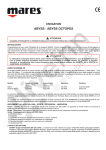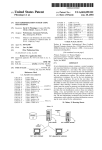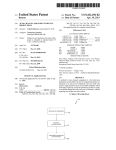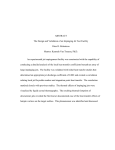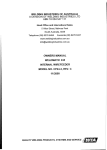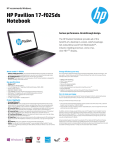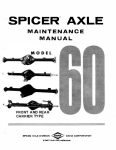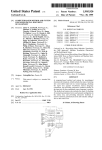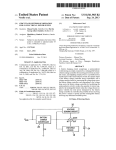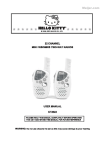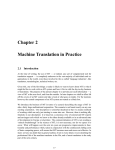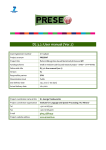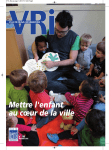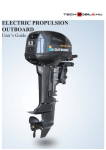Download Integrated authoring and translation system
Transcript
US006163785A
Ulllted States Patent [19]
[11] Patent Number:
Carb0nell et al.
[45]
[54]
INTEGRATED AUTHORING AND
Date of Patent:
U.S. Cl. ........................ .. 707/530; 707/500; 707/531;
[58]
Field of Search .................................. .. 704/1, 2, 4, 7,
707/536; 704/2; 704/4; 704/8; 704/9; 704/10
[75] Inventors: gillimie G.ICaéb(;lnell,1\P[ittsburgIl111, Pa.;
.
a up,
orton,
704/8, 9, 10; 707/500, 530, 531, 536
.;
Timothy J. Harris, Pekin, Ill.; James
W. Higdon, Lacon, Ill.; Dennis A. Hill,
[56]
References Cited
East Peoria, 111.; David C. Hudson,
U.S. PATENT DOCUMENTS
?iiéliltlemlmil?vld .NliisJlgen’l
2
em“
'
*Dec. 19, 2000
[52]
TRANSLATION SYSTEM
ar ene
6,163,785
enmc/
11“ aP>
2
4,661,924
4/1987 Okamoto et al. ......................... .. 704/8
4,771,401
9/1988 Kaufman et al.
5,1939%)’
YMAIgIEYSEHiDPtFtSbHYEhiFaJ
16 3e
auer, 1 S urg > 31-;
4,821,230 5/1989
4/1989 Tennant
Kumano etetal.
4,829,423
al. .
Roy F. Busdiecker, III, Pittsburgh, Pa;
Philip J. Hayes, Pittsburgh, Pa.; Alis0n
4,954,984
K. Huettner, Pittsburgh, Pa.; Bruce M.
. 707/533
704/6
. 704/8
9/1990 Kaijima et al. ........................... .. 704/5
_
_
(L15t Con?rmed on next Page)
McLaren, Pittsburgh, Pa.; Irene
Nirenburg, Pittsburgh, Pa.; Eric H.
FOREIGN PATENT DOCUMENTS
Riebling, Pittsburgh, Pa.; Linda M.
Schmandt, Pittsburgh, Pa_; John F,
Sweet, Pittsburgh, Pa; Kathryn L_
O 387 226
O 469 884
WO 94/06086
9/1990
2/1992
3/1994
European Pat. Off. .
European Pat. Off. .
WIPO ........................... .. G06F 15/38
Baker, Pittsburgh, Pa.; Nicholas D.
Brownlow, Pittsburgh, Pa.; Alexander
M- Franz, Pittsburgh, Pa; Susan EHolm, Plttsburgh, Pa; J Ohn Robert
OTHER PUBLICATIONS
“Interactive Author—Assistance Tool,” IBM Technical Dis
closure Bulletin, vol. 28, N0. 12, pp. 5284—5286, May 1986.
Russell Leavitt, Pittsburgh, Pa.; Deryle
W. L0nsdale, Bridgeville, Pa.; Teruko
(List continued on next page)
Mitamura; Eric H. Nyberg, 3rd, both
_
of Pittsburgh, pa_
_
irzntary lgcamtner?mtanliell glodd VoeltZ
sszstant
[73] Assignee; Caterpillar Inc” Peoria, 111_
xamzner— 0 n
.
ayes
Attorney, Agent, or Firm—James R. Yee; Kevin M. Kercher;
Jeffrey L. Myers
[ ]
Notice.
This patent is sub]ect to a terminal dis
[57]
ABSTRACT
claimer.
The present invention is a system of integrated, computer
[21] Appl. No.: 09/309,802
[22] Filed:
based processes for monolingual information development.
May 11’ 1999
and multilingual translat1on.'An interactive text editor
.
enforces lexical and grammatical constraints on a natural
language subset used by the authors to create their text,
.
Related U'S' Apphcatlon Data
Which they help disambiguate to ensure translatability. The
[63] Continuation of application No. 08/632,237, Apr. 15, 1996,
reSu1t_1ng translatable Source language text undergoes
which is a continuation of application No. 08/363,309, Dec.
machlne translatlon lnto any one of a Set of target languages>
22,1199t4, PIaIt.
Without the translated text requiring any postediting.
app 1ca ion
[51]
0.
,
,
WlAl‘ICl1l9I9S2a iontcilnuatcion of
ep.
,
, a an one .
Int. Cl.7 .................................................... .. G06F 17/28
42 Claims, 10 Drawing Sheets
SOURCE
CORRECTED TEXT
6,163,785
Page 2
Meyer,
US. PATENT DOCUMENTS
5,175,684
12/1992 Chong ....................................... .. 704/3
5,225,981
7/1993 Yokogawa
704/2
5,243,519
9/1993 Andrews et a1. .
704/8
5,677,835 10/1997 Carbonell et a1.
5,995,920
11/1999
704/8
Carbonell et a1. ........................ .. 704/9
OTHER PUBLICATIONS
“LeXicographic
Principles
&
Design
for
Knowledge— Based Machine Translation”—Paper No.
CMU—CMT—90—118, Carnegie Mellon Center.
Mitamura, “An Ef?cient Interlingua Translation System for
Multi—Lingual Document Production” Wash.D.C. Jul. 2—4,
1991.
Nirenburg, Acquisition of Very Large Knowledge Bases:
Methodology, Tools and Applications, Carnegie Mellon,
“Structured, Universal Natural—Language Generator for
Sophisticated Target—Language Generation in Machine
Translation Systems,” IBM Technical Disclosure Bulletin,
vol. 31, No. 5, pp. 407—408, Oct. 1988.
Patent Abstracts of Japan, vol. 15, No. 376 (P—1255), Sep.
24, 1991, & JP—A—03 148760, Jun. 25, 1991.
“KBMT—89 Project Report”, Carnegie Mellon Center for
Machine Translation, Feb. 1989.
Paper No. CMU—CMT—88—108, Jun. 1988.
Nirunburg, “Machine Translation: A Knowledge Based
Approach”, Morgan Kaufmann Publishers, Inc. 1992.
Adriaens, “From Cogram to Alcogram: Toward a Controlled
Tomita et al, “The Universal Parser Architecture for Knowl
English Grammar Checker” Proc.of Coling—92, Nantes,
pp.595—601, Aug. 23, 1992.
Carbonell et al, “Knowledge—Based Machine Translation,
the CMU Approach”, Machine Translation—Theoretical
and Methodological Issues.
Carbonell, Steps toward Knowledge—Based Machine Trans
lation, IEEE Trans on Pattern Analysis and Machine Intel
Somers, “An Introduction to Machine Translation”, Aca
demic Press, Oct. 1991.
Teruko Mitamura, “The Hierarchial OrganiZation of Predi
cate Frames for Interpretive Mapping in Natural Language
Proc”, #CMU—CMT—90—117.
edge—Based Machine Translation”, Carnegie Mellon Center
for Mach. Trans.
Tomita, “Generation Kit and Transformation Kit—Version
3.2—User’s Manual”, Carnegie Mellon Center for Mach
Translation —#CMU—CMT—88—Memo.
Tomita, “The Generalized LR Parser/Compiler Version
ligence, No. 4 pp.376—392.
8.1:User’s Guide” Carnegie Mellon Center for Mach Trans
Eric H. Nyberg, 3rd, “The Framekit User’s Guide—Version
2.0”, Carnegie Mellon Center for Machine Translation,
Paper No. CMU—CMT—Memo.
Goodman, The KBMT Project: A Case Study in Knowl
lation, Paper No. CMU—CMT—88—Memo.
PC”, Newsbytes, Dialog File 275 :Computer DBTM, Mar. 27,
edge—Based Machine Translation, Morgan Kaufmann Pub
lishers, Inc. 1991.
PereZ et al, “Language Translation Program”, Library Soft
ware Review, vol. 10, Issue 3, 6 pages, May/Jun. 1991.
IBM, “New for IBM: Russian Language Translator for the
1990.
U.S. Patent
Dec. 19,2000
Sheet 1 0f 10
6,163,785
INTEGRATED AUTHORING AND TRANSLATION SYSTEM
[-
l
|
l
l
l
l
l
l
l
—
_
_
_
_
_
_
_
_
_
_
_
_
_
_
_
TE~———-~MT
_
___l
l
l
l
:
I|
l
U.S. Patent
Dec. 19, 2000
6,163,785
Sheet 3 0f 10
AUTHOR
£160
V
SOURCE/
2151
CORRECTED TEXT
220
V
CHECK VOCABULARY
1217
V
ANALYZE 1230
V
DISAMBIGUATED/
CONSTRAINED TEXT
V
INTERPRET 1250
U
( INTERLINGUA h 260
V
GENERATE 1270
V
( TARGET TEXT )1 280
Fig. 2
240
U.S. Patent
Dec. 19,2000
(
6,163,785
Sheet 4 0f 10
GsL TEXT )—z 305
7
ANALYSIS LL127
T
( INTERLTNGUA y-l 260
123A
T
/\/
1238
v
/\/
1236
T
/
TARGET TEXT
TARGET TEXT
TARGET TEXT
GENERATOR
GENERATOR
2
GENERATOR
3
T
TT
( TARGET TEXT 1 )
306
(TARGET TEXT 2)
308
(TARGET TEXT ,3)
310
120
Fig. 3
U.S. Patent
Dec. 19, 2000
6,163,785
Sheet 5 0f 10
“IE" 410 AS VIEWED IN THE AUTHORING TOOL
410
"IE" 450 AS FILED
450
415
E
‘I UNIQUE HEADING I
=UN|QUE HEADING
420
UNIQUE OBJECT
SHARED
GRAPHICS
LIBRARY \
430
N
GRAPHIC
460A
~~~c;\cRAPHIcs\NAME1
435
/,'C;\TABLES\NAME2
SHARED
TABLES /
LIBRARY
~ 825%?
TABLE
/
4255
w
460B
c; TE
/‘r \ m
NAME3
SHARED OBJECT
SHARED /
TEXT
LIBRARY
N
450C
\
I
SHARED
AUDIO
SHARED
vIDEo
LIBRARY
N
4600
LIBRARY
"
RELEASE LIBRARY
:5;
I590
N
IE3
IE7
IE1 1
460E
IE4-
IE8
IE12
/\./
470
BOOK 1
IE1
IE3
IE5
IE7
/\/
480
BOOK 2
IE1
IE3
IE6
IE8
/x/
485
Fig. 4
U.S. Patent
A
Dec. 19,2000
Sheet 6 0f 10
6,163,785
‘I
3
- SEMANTIC INFO
SYNONYMS
(WHICH CONCEPTS
RELATE wITH
OTHER CONCEPTS)
2
USAGE
EXAMPLES
DEFINITION
KERNEL
——————— ——-OBJECTS
~OONTE><T
'ATTRIBUTES
1510
EVENTS
‘RELATIONSHIPS
INFO
i (VERB ARGUMENT
VERB CASE)
LE
3520
K530
Fig. 5
U.S. Patent
Dec. 19, 2000
TEXT
Sheet 7 0f 10
6,163,785
605
V
610
VOCABULARY
1
CHECK
SPELL
‘__’ CHECK
r
LEXICALLY
CONSTRAINED TEXT
~61 7
V
GRAMMAR
CHECK
.
1620
T
CSL TEXT
DISAMBIGUATION
625
I 630
TRANSLATAB LE
TEXT
Fig. 6
635
1615
U.S. Patent
Dec. 19,2000
Sheet 8 0f 10
6,163,785
( START h 702
T
EELECT FIRST TERM IN UNIT
'
706
710
IS
TERM IN CSL
DICTIONARY?
SELECT
NEXT TERM
718
Fl 1
SPELL
CHECK
“L722
ARE
7T 4
MOTIQNE TTESMS
UN”?
AUTHOR
CORRECTS 1
SPELLING
726
734
742
ITEM IN CSL
VOCABULARY?
740
736
THE DM HAVE
A SYNONYM?
//
R’gggg‘s _
TEXT
SYSTEM RUNS
AGAINST LE/DM
V
DISPLAY
SYNONYMS AND _,_
CHOOSE
729
Fig. 7
738
U.S. Patent
Dec. 19, 2000
Sheet 9 0f 10
6,163,785
FROM 620
SYNTACTICALLY
CORRECT TEXT
805
V
SEMANTIC ANALYSIS
1810
815
SEMANTICALLY
INTERLINGUA
CORRECT?
AUTHOR
CORRECTS
1
825
Fig. 8
820
U.S. Patent
Dec. 19,2000
Sheet 10 0f 10
_
10MN|E£r§
_0%058m
_ENDAWlm‘EZi
RP
'
mom
0m
Ema/i m0<325
6,163,785
6,163,785
1
2
INTEGRATED AUTHORING AND
TRANSLATION SYSTEM
due to several factors. One is the rapid increase in the text
associated With conducting business internationally. Another
is the large number of languages that such texts must be
This is a continuation application of application Ser. No.
08/632,237, ?led Apr. 15, 1996, Which is a continuation of
Ser. No. 08/363,309, ?led Dec. 22, 1994, (issued Oct. 14,
5
resulted in frequent revisions of text documents, Which
requires subsequent translation of neW versions.
1997 as 5,677,835), Which is a ?le Wrapper continuation of
application Ser. No. 07/941,180, ?led Sep. 4, 1992 (noW
Many organiZations have the responsibility for creating
abandoned).
and distributing information in multiple languages. In the
10
BACKGROUND OF THE INVENTION
1. Field of The Invention
particularly, to a system for authoring and translating
15
or post-editing required.
2. Related Art
20
of vast quantities of information in a variety of documents
is confronted With the need to ensure their full intelligibility.
Ideally, such documents should be authored in simple, direct
language featuring all necessary expressive attributes to
optimiZe communication. This language should be consis
25
tent so that the organiZation is identi?ed through its single,
stable voice. This language should be unambiguous.
The pursuit of this kind of Writing excellence has led to
the implementation of various disciplines designed to bring
the authoring process under control. Yet authors of varied
standards are elusive—dif?cult to de?ne and enforce. Efforts
35
and hoWever successful, these results push up documenta
tion authoring costs.
Recent attempts at surrounding authors With the softWare
environment that might enhance their productivity and the
quality of their Writing have only succeeded in providing
used in the documentation. Because of these problems,
feWer manuals than Would be ideal are actually translated.
In the areas of research and development, the explosion of
knoWledge Which has occurred in the last century has also
geometrically increased the need for the translation of
documents. No longer is there one predominant language for
documents in a particular ?eld of research and development.
Typically, such research and development activities are
taking place in several advanced industrialiZed countries,
such as, for example, the United States, United Kingdom,
France, Germany, and Japan. Many times there are addi
tional languages containing important documents relating to
the particular area of research and development. Advances in
30
capabilities and backgrounds cannot comfortably be made to
?t a uniform skill standard. Writing guidelines, rules and
aimed at both standardiZing and improving on the quality of
Writing tend to meet With mixed results. HoWever achieved
cess. Translations are usually inconsistent oWing to the
individual interpretation of the translators Who are not
necessarily Well-versed in the application speci?c language
constrained-language text to a foreign language With no pre
Every organiZation Whose activities require the generation
global marketplace, the manufacture must ensure that the
manuals are Widely available in the host languages of their
target markets. Manual translation of documents into foreign
languages is a costly, time-consuming, and inef?cient pro
The present invention relates generally to computer-based
document creation and translation system and, more
translated into in order for a company to engage in global
commerce. Athird is the rapid pace of commerce Which has
40
technology, particularly in electronics and computers, have
further accelerated the production of text in all languages.
The ability to produce text is directly proportional to the
capability of the technology that is used. When documents
had to be hand-Written, for example, an author could only
produce a certain number of Words per unit of time. This
increased signi?cantly, hoWever, With the advent of
mechanical devices, such as typeWriters, mimeograph
machines, and printing presses. The advent of electronic,
computer, and optical technology increased the capability of
the author even further. Today, an average author can
spell checkers. The effectiveness of other Writing softWare
produce signi?cantly more text in a given unit of time than
has so far been disappointingly Weak.
When the need to deliver information calls for the cross
any author could produce using the hand-Written methods of
the past.
This rapid increase in the amount of text, coupled With
ing of linguistic frontiers, the challenges multiply. The
organiZation that needs to clear a channel for its information
How ?nds itself to a great extent, if not totally, dependent on
translation.
Translation of text from one language to another language
has been done for hundreds of years. Prior to the advent of
computers, such translation Was done completely manually
by experts, called translators, Who Were ?uent in the lan
guage of the original text (source text) and in the language
of the translated text (target text). Typically, it Was preferable
for the translator to have originally learned the target lan
guage as his/her native tongue and subsequently have
learned the source language. Such an approach Was felt to
result in the most accurate and ef?cient translation.
Even the most expert translator must take a considerable
amount of time to translate a page of text. For example, it is
45
enormous advances in technology, has caused considerable
attention to be paid to the subject of translation of text from
its source language to a target language(s). Considerable
research has been done in universities as Well as in private
50
Without the intervention of a human translator.
Computer-based systems have been devised Which
attempt to perform machine translation (MT). Such com
55
puter systems are programmed so as to attempt to automati
cally translate source text as an input into target text as an
output. HoWever, researchers have discovered that such
computer systems for automatic machine translation are
impossible to implement using present technology and theo
60
retical understanding. No system exists today Which can
perform the machine translation of a source natural language
to a target natural language Without some type of editing by
expert editorsltranslators. One method is discussed beloW.
In a process called pre-editing, source text is initially
estimated that an expert translator translating technical text
from English to Japanese can only translate approximately
300 Words (approximately one page) per hour. It can thus be
seen that the amount of time and effort required to translate
a document, particularly a technical one, is extensive.
The requirements for translation in business and com
merce has groWn steadily in the last hundred years. This is
and governmental laboratories, Which has been devoted to
trying to ?gure out hoW translation can be accomplished
65
revieWed by a source editor. The task of the source editor is
to make changes to the source text so as to bring it into
conformance With What is knoWn to be the optimal state for
6,163,785
4
3
translation by the machine translation system. This conform
FIG. 9 is an informational How and architectural block
diagram of MT 120
ance is learned by the source editor through trial and error.
The pre-editing process just described may go through
DETAILED DESCRE?ON OF THE PRESENT
INVENTION
iterations by additional source editors of increasing compe
tence. The source text thus prepared is submitted for pro
cessing to the machine translation system. The output is
target language text Which, depending on the purposes of the
translation of quality requirements of the user, may or may
not be post-edited.
If the translation quality required must be comparable to
that of pro?cient human translation, the output of machine
translation Will most likely have to be post-edited by a
competent translator. This is due to the complexity of human
language and the comparatively modest capabilities of the
machine translation systems that can be built With present
technology, Within natural limitations of time and resources,
and With a reasonable expectation of meeting cost
10
I. Integrated System OvervieW
The computer-based system of the present invention
provides functional integration of:
1) An authoring environment for the development of
documents, and
2) A module for accurate, machine translation into mul
tiple languages Without pre- or post-editing.
UtiliZing this technology in the production of multilingual
15
documentation, the user is assured of consistently accurate,
timely, cost-ef?cient translation, Whether in small or large
volumes, and With virtually simultaneous release of infor
mation in both the source language and the languages
targeted for translation.
effectiveness requirements. Most of the modest systems that
are built require, indeed, the postediting activity, intended to
approximate, by Whatever measure, the quality levels of
purely human translation.
Once such system is the KBMT-89 designed by the Center
The decision to lirdc the source language authoring func
tion together With the translation function is based on tWo
principles:
1) In a multinational, multilingual business environment,
the information is not considered to be fully developed
until it is deliverable in the various languages of the
for Machine Translation, Carnegie Mellon University, Which
translates English to Japanese and Japanese to English. It
operates With a knoWledge based domain model Which aids
users.
in interactive disambiguation (i.e., editing of the document
2) Combining the authoring and translation processes
to make it unambiguous). HoWever, this interactive disam
biguation is not typically done interactively With an author.
Within a uni?ed frameWork leads to ef?ciency gains
that cannot otherWise be achieved.
FIG. 1(a) shoWs a high level block diagram of the
Once the system ?nds an ambiguous sentence that it cannot
disambiguate, it must stop the process and resolve ambigu
ities by asking a author/translator a series of multiple-hoice
questions. In addition, since the KBMT-89 does not utiliZe
a Well-de?ned controlled input language the socalled trans
lator assisted interactive disambiguation produces text
Which requires postediting.
Integrated Authoring and Translation System (AATS) 105.
The IATS 105 provides a specialiZed computing environ
ment dedicated to supporting an organiZation in authoring
documentation in one language and translating it into vari
35
In vieW of the above, it Would be advantageous to have a
1) Authoring—one subgroup of the programs provides an
interactive computeriZed Text Editor (TE) 140 Which
translation system that eliminates both pre- and post-editing.
enables authors to create their monolingual text Within
the lexical and grammatical constraints of a domain
SUMMARY OF THIE INVENTION
bound subset of a natural language, the subset desig
The present invention is a system of integrated, computer
based processes for monolingual document development
and multilingual translation. An interactive computeriZed
nated Constrained Source Language (CSL).
Additionally, the TE 140 enables authors to further
prepare the text for translation by guiding them through
text editor enforces lexical and grammatical constraints on a
natural language subset used by the authors to create their
text, and supports the authors in disambiguating their text to
ensure its translatability. The resulting translatable source
language text undergoes machine translation into any one of
a set of target languages, Without the translated text requir
45
the process of text disambiguation Which renders the
text translatable Without pre editing;
2) Translation—another subgroup of the programs pro
vides the Machine Translation (M) 120 function,
capable of translating the CSL into as many target
ing any post-editing.
languages as the generator module has been pro
grammed to generate, With the resulting translation
requiring no post-editing.
BRIEF DESCRIFIION OF THE DRAWINGS
FIGS. 1(a) and 1(b) are high level block diagrams of the
architecture of the present invention.
FIG. 2 is a high level ?oWchart of the operation of the
present invention.
FIG. 3 is a high level informational How and architectural
block diagram of MT 120.
ous others. These tWo distinct functions are supported by an
integrated group of programs, as folloWs:
For a system that features translation as a central
component, the integration of the authoring and the trans
55
lation functions of the present invention Within a uni?ed
frameWork is the only Way devised to date that eliminates
both pre- and postediting.
The text (TE) 140 is a set of tools to support the authors
and editors in creating documents in CSL. These tools Will
help authors to use the appropriate CSL vocabulary and
FIG. 4 shoWs an example of an information element.
FIG. 5 is a block diagram of the domain model 500.
grammar to Write their documents. The TE 140 communi
FIG. 6 is a high level How diagram of the operation of the
cates With the author 160 (and vice versa) directly.
language editor 130.
FIG. 7 is a How diagram illustrating the operation of the
vocabulary checker 610.
FIG. 8 is a high level How diagram of the disambiguation
block 630.
65
Referring to FIG. 1(b), the IATS 105 is divided into four
main parts to perform the authoring and translation func
tions: (1) a Constrained Source Language (CSL) 133, (2) a
Text Editor (LE) 140, (3) a MT 120, and (4) a Domain
Model (DM) 137 The Text Editor 140 includes a Language
6,163,785
5
6
Editor 130 and a Graphics Editor 150. In addition, a File
the declarative knoWledge about the CSL vocabulary used
by the MT analyZer 127 and the LE 130.
FIG. 2 shoWs a high level ?oWchart of the operation of
IATS 105. The MT 120, LE 130, text editor 140, and
graphics editor 150 are all controlled by the FMS 110.
Control lines 111—113 provide the necessary control infor
mation for proper operation of IATS 105.
Management System (FMS) 110 is also provided for con
trolling all processes.
The CSL 133 is a subset of a source language Whose
grammar and vocabulary cover the domain of the author’s
documentation Which is to be translated. The CSL 133 is
de?ned by speci?cations of the vocabulary and grammatical
Initially, the author 160 Will use the FMS 110 to choose
a document to edit, and the FMS 110 Will start the text editor
constructions alloWed so that the translation process is made
possible Without the aid of pre- and post editing.
The TE 140 is a set of tools to support authors and editors
10
in creating g documents in CSL. These tools Will help
authors to use the appropriate CSL vocabulary and grammar
strained and ambiguous text into the IATS 105, as shoWn in
blocks 160 and 220. The author 160 Will use standard editor
commands to create and modify the document until it is
to Write their documents. The LE 130 communicates With
the author 160 (and vice versa) via the text editor 140. The
author has bidirectional communication via line 162 With the
15
text editor 140. The LE 130 informs the author 160 Whether
Words and phrases that are used are in CSL. The LE 130 is
able to suggest synonyms in CSL for Words that are relevant
to the domain of information Which includes this document,
but are not in CSL. In addition, the LE 130 tells an author
160 Whether or not a piece of text satis?es CSL grammatical
constraints. It also provides an author With support in
disambiguating sentences that may be syntactically correct
but are semantically ambiguous.
The MT 120 is divided into tWo parts: a MT analyZer 127
and a MT generator 123. The MT analyZer 127 serves tWo
purposes: it analyZes a document to ensure that the docu
ment unambiguously conforms to CSL and produces inter
lingua text. The analyZed CSL-approved text is then trans
lated into a selected foreign (target) language 180. The MT
120 utiliZes an Interlingua-based translation approach.
Instead of directly translating a document to another foreign
language, the MT generator 123 transforms the document
into a language-independent, computer-readable form called
Interlingua and then generates translations from the Inter
ready to be checked for CSL compliance. Note that is it
anticipated that authors Will mostly enter text that is sub
stantially prepared With the CSL constraints in mind. The
text Will then be modi?ed by the author in response to
system feedback, based on violations to the predetermined
lexical and grammatical constraints, to conform to the CSL.
This is, of course, much more ef?cient than initially entering
totally unconstrained text. HoWever, the system Will operate
properly even if totally unconstrained text is entered from
the start.
25
The author’s communication With the LE 130 consists of
mouse click or keystroke commands. HoWever, one should
note that other forms of input may be used, such as but not
limited to the use of a stylus, voice, etc., Without changing
the scope or function of the present invention. An example
of an input is a command to perform a CSL check or to ?nd
the de?nition and usage example for a given Word or phrase.
The CSL text that may contain residual ambiguity or
stylistic problems is analyZed for conformity With CSL and
35
lingua text. As a result, translated documents Will require no
postediting. A version of the MT 120 is created for each
language and Will consist primarily of a set of knoWledge
sources designed to guide the translation of Interlingua text
to foreign language text. In particular, for every neW target
language, a neW MT generator 123 must be individually
developed.
When fully functional, the LE 130 Will sometimes need to
ask the author 160 to choose from alternative interpretations
for certain sentences that satisfy CSL grammatical con
straints but for Which the meaning is unclear. This process is
knoWn as disambiguation. After the LE 130 has determined
that a particular part of text uses only CSL vocabulary and
satis?es all CSL grammatical constrains, then the text Will be
140, displaying the ?le for the speci?ed document. Via the
text editor 140, the author enters text that may be uncon
checked for compliance With the grammatical rules con
tained in the knoWledge bases, as shoWn in block 230. The
author is provided feedback to correct any mistakes via
feedback line 215. Speci?cally, the LE 130 provides infor
mation regarding non-CSL Words and phrases and sentences
to the author 160. Finally, the text is checked for any
ambiguous sentences. The LE prompts the author to select
an appropriate interpretation of a sentence’s meaning. This
process is repeated until the text is fully disambiguated.
Once the author has made all the necessary corrections to
the text, and the analysis phase 230 has completed, the
45
disambiguated/constained text 240 is passed to the MT
analyZer and interpreter 250. The interpreter resides in the
MT analyZer 127 together With the syntactic part of the
analyZer and translates the disambiguated/constrained text
240 into interlingua 260. The interlingua 260 is in turn
translated by generator block 270 into the target text 280. As
labeled CSL-approved, pending this disambiguation. As
explained beloW, disambiguation Will not require any
shoWn in FIG. 3, the interlingua text 260 is in a form that can
be translated to multiple target languages 306—310.
By requiring and enabling the author to create documents
that conform to speci?c vocabulary and grammatical
changes to the author-visible aspects of the text. After the
text has been disambiguated it Will be ready for translation
into the target language 180.
In practice, the LE 130 is built as an extension to the text 55 constraints, it is feasible to perform the accurate translation
editor 140 Which provides the basic Word processing func
tionality required by authors and editors to create text and
tables. The graphics editor 150 is used for creating graphics.
The graphics editor 150 provides a means for accessing the
of constrained-language texts to foreign languages With no
postediting required. Postediting is not required since the LE
vocabulary check block 217 and analysis block 230 have
caused the author to modify and/or disambiguate all possibly
text labels on graphics through the text editor 140, so these
text labels can be CSL, approved as Well.
The LE 130 (via text editor 140) communicates With the
MT analyZer 127 and, through it, With the DM 137 during
disambiguation via bidirectional socket-to-socket line 132.
In the preferred embodiment of the present invention, the
DM is one of the knoWledge bases that feeds the MT
analyZer 127. The DM 137 is a symbolic representation of
65
ambiguous sentences and all non-translatable Words from
the document before translation.
II. Detailed Description of the Functional Blocks
In a preferred embodiment, each author Will have sole use
of a DECstation With 32 Meg of RAM, a 400-megabyte disk
drive, and a 19-inch color monitor. Each Workstation Will be
con?gured for at least 100 Meg of sWap from its local disk.
In addition to the authors’ Workstations, DECservers Will be
6,163,785
8
7
used as ?le servers, one for every tWo authoring groups, for
lary that cannot (readily) be exhaustively speci?ed (for
a total of no more than 45 users per ?le server. Furthermore,
example, part numbers, error messages from
machinery). SGML tags can be put around these items
to indicate to the system that they are exempt from
authoring Workstations Will reside on an Ethernet local
netWork. The system uses the Unix operating system (a
Berkeley Standard Distribution (BSD) derivative is prefer
checking;
able to a System V (SYSV) derivative). A C programming
language compiler and OSF/Motif libraries are available.
(3) identifying contents (e.g., part number) as discussed in
The LE Will be run Within a Motif WindoW manager. It
(4) alloWing partial sentences to be translated (e.g., bul
(2);
should be noted that the present invention is not limited to
leted items);
(5) assisting in translating tables (one cell at a time) by
the above hardWare and softWare platforms and other plat
forms are contemplated by the present invention.
identifying structure of text. This feature is similar to
A. Text Editor
that described in (1);
The preferred embodiment of the present invention pro
(6) assisting the parsing process (described beloW)
vides a text editor 140 Which alloWs the author to input
information that Will eventually be analyZed and ?nally
translated into a foreign language. Any commercially avail
15
through (2), (3), (4), (5);
(7) assisting in disambiguation by providing a means of
able Word processing softWare can be used With the present
inserting invisible tags into the source text so as to
invention. Apreferred embodiment uses a SGML text editor
indicate the correct interpretation of an ambiguous
140 provided by ArborText (ArborText Inc., 535 West
sentence;
William St., Ann Arbor, Mich. 48103). The SGML text
editor 140 provides the basic Word processing functionality
required by authors and editors, and is used With softWare by
(8) assisting in translating currencies and mathematical
InterCap (of Annapolis, Maryland) for creating graphics.
(9) providing a means of labeling a portion of text as
units through the identi?cation of speci?c types of text
that require special treatment.
The present invention utiliZes a SGML text editor 140
since it creates text using Standard GeneraliZed Markup
Language (SGML) tags. SGML is an International Standard
25
markup language for describing the structure of electronic
documents. It is designed to meet the requirements for a
translatable. In other Words, certifying that a portion of
text has advanced through the process outlined beloW
and that the text is unambiguous constrained text that
can be translated Without postediting.
In the past, authors have created (by Way of the text editor
Wide range of document processing and interchange tasks.
140) electronic documents (text only—no graphics) that
SGML tags enable documents to be described in terms of
represented a complete “book.” This implies that all Work is
their content (text, images, etc) and logical structure
(chapters, paragraphs, ?gures, tables, etc.) In the case of
done by one Writer, and that the information created is not
easily reused. The present invention, hoWever, compiles (or
larger, more complex, electronic documents, it also makes it
possible to describe the physical organiZation of a document
into ?les. SGML is designed to enable documents of any
type, simple or complex, short or long, to be described in a
manner that is independent of both the system and applica
creates) books (manuals, documents) from a set of smaller
35
pieces or information elements, Which implies that the Work
can be done by multiple Writers. The result of this invention
is enhanced reusability. An information element is de?ned as
the smallest stand-alone piece of service information about
a specialiZed domain. It should be noted, hoWever, that
although a preferred embodiment utiliZes information
elements, the present invention can produce accurate, unam
biguous translated documents Without the use of information
elements.
tion. This independence enables document interchange
betWeen different systems for different applications Without
misinterpretation or loss of data.
SGML is a markup language, that is, a language for
“marking up” or annotating text by means of or by using
coded information that adds to the conventional textual
FIG. 4 shoWs an example of an information element 410
information conveyed by a given piece of the text. In most
Which includes a “unique” heading 415, a “unique” block of
text 420, a “shared” graphic 430, a “shared” table 435, and
cases it takes the form of sequences of characters at various 45
points throughout an electronic document. Each sequence is
distinguishable from the text around it by the special char
acters that begin and end it. The softWare can verify that the
correct markup has been inserted into the text by examining
a “shared” block of test 425.
“Unique” information is that information Which applies
only to the information element in Which it’s contained. This
implies that the “unique” information is ?led as part of the
information element 450.
the SGML tags upon request. The markup is generaliZed in
that it is not speci?c to any particular system or task. For a
more in depth discussion of SGML tags see International
Standard (ISO) 8879, Information processing—Text and
of?ce systems—Standard GeneraliZed Markup Language
(SGML), Ref. No. ISO 8879—1986(E).
A “shared” object (a graphic, table, or block of text) is
information that is “referenced” in the information element.
The content of “shared” objects are displayed in the author
ing tool but only “pointed to” in the ?led information
55
The folloWing capabilities are possible due to the use of
the SGML tags:
element 450.
“Shared” objects differ from information elements in that
units. The text editor 140 softWare uses both punctua
they do not stand-alone (i.e., they do not convey enough
information by themselves to impart substantive
information). Each “shared” object is in itself a separate ?le
tion and SGML tags to recogniZe translatability units in
as shoWn in block 450.
(1) dividing documents into fragments or translatable
the source input text (e.g., an SGML tag is necessary to
Information elements are formed by combining “unique”
identify section titles);
blocks of information (text and/or tables) With one or more
“shared” objects. Note that “unique” heading 415 and
“unique” text 420 is combined With “shared” graphic 430,
(2) shielding (insulating) units that Will not be translated.
Although the system is based on the premise that all
Words and sentences Will belong to the constrained
language that cannot be predicted in advance (for
“shared” table 435, and “shared” text 425. A set of one or
more information elements make up a complete document
example, names and addresses) or classes of vocabu
(book).
65
6,163,785
10
“Shared” objects are stored in “shared” libraries. Library
In most cases, the UI provides automatic replacement of
non-CSL vocabulary With CSL vocabulary, With no need for
types include “shared” graphic libraries 460a, “shared”
tables libraries 460b, “shared” text libraries 460C, “shared”
audio libraries 460d, and “shared” video libraries 460e. A
shared object is stored only one time. When used in indi
the user to modify the CSL Word to ensure that it is in the
appropriate form. HoWever, there are some cases in Which
the vocabulary checker (described beloW), Which does no
parsing of a document, Will not be able to identify the correct
form to provide. Consider the folloWing caption, in the case
Where the verb “vieW” is not in CSL, but has the CSL
synonym “see”:
vidual information elements, only “pointers” to the original
shared object Will be placed in the information shared ?le
450. This minimizes the amount of disk space that Will be
required. When the original object is changed, all those
information elements that “point” to that object are auto
10
Direction of Crankshaft Rotation (When vieWed from
?yWheel end)
matically changed. A shared object can be used in any
The Vocabulary Checker Will not knoW if “saW” or “seen”
publication type.
should be offered as a synonym for “vieWed.” Of course, in
A“shared information element” is an information element
that is used in more than one document. For example, the 15 this case a reasonable course of action might be to offer both
possibilities and alloW the author to choose the appropriate
same four information elements in release library 470 are
one. Because there is no certainty that every case Will alloW
used to create portions of documents 480 and 485.
a presentation that enables the author to order a direct
All communication betWeen the author and the LE 1330
replacement. LE 1330 provides a list of replacement options
Will be mediated by an LE User Interface (UI), implemented
in the correct form Where possible. There may be cases,
though, When the author Will ?nd it necessary to edit a
as either an extension of standard SGML Editor facilities
such as menu options, or in separate WindoWs. The UI
provides and manages access to and control of the CSL
suggested CSL Word or phrase before requesting that it be
put into the document.
checkers and CSL vocabulary look-up, and it is the primary
Finally, the LE UI provides support for disambiguating
tool enabling users to interact With the CSL LE. Although
the meaning of sentences. It does this by providing a list of
the term “user interface” is often used in a more general 25 possible alternative interpretations to the author, alloWs the
sense to refer to the interface to an entire softWare system,
author to select the appropriate interpretation, and then tags
here the term Will be restricted to mean the interface to the
the sentence so as to indicate that authors selection.
CSL checkers, vocabulary look-up facility, and the disam
C. File Management System
biguation facility.
The File Management System (FMS) 110 serves as the
authors’ interface to the IE Release Library 470 and the
SGML text editor 140. Typically, authors Will select an IE to
edit by indicating the ?le for that IE in the FMS interface.
The FMS 110 Will then initiate and manage an SGML Editor
session for that IE. Finished documents Will be forWarded to
Among other things, the UI must provide clear informa
tion regarding (a) the actions the LE is taking, (b) the result
of these actions, and (c) any ensuing actions. For example,
Whenever an action initiated through the UI introduces more
than a very brief, real-time pause, the UI should inform the
author of a possible delay by means of a succinct message.
The author can invoke LE functionality by choosing an
option from a pull-doWn menu in text editor 140. The
available options alloW the author to initiate and vieW
35
D. Constrained Source Language (CSL)
Given the complexity of today’s technical documentation,
high quality machine translation of natural language uncon
strained texts is practically impossible. The major obstacles
feedback from CSL checking (both vocabulary and grammar
checking) and from vocabulary look-up. The author can
request that checking be initiated on the currently displayed
to this are of a linguistic nature. The crucial process in
document or request vocabulary look-up on a given Word or
translating a source text is that of rendering its meaning in
phrase.
The UI Will clearly indicate each instance of non-CSL
language found in the document. Possible Ways of indicating
non-CSL language include the use of color and changes to
font type or siZe in the SGML Editor WindoW. The UI Will
display all knoWn information regarding any non-CSL Word.
For example, in appropriate cases the UI Will display a
message saying that the Word is non-CSL but has CSL
45
Some of the most vexing translation problems result from
those features inherent in language Which hinder analysis
and generation.
A feW of these features are:
1. Words With more than one meaning in an ambiguous
In cases Where a Vocabulary Checker report includes a list
context
of alternatives to the non-CSL Word in focus (for example,
spelling alternatives or CSL synonyms), the author Will be
Example: Make it With light material.
55
[Is the material “not dark” or “not heavy”?]
2. Words of ambiguous makeup
author may have to modify (i.e., add the appropriate ending)
Example: The German Word “Arbeiterinformation” is
either
“information for Workers” [Arbeiter+Information] or
“formation of female Workers” [Arbeiterin+Formation]
the selected alternative to ensure that it is in the appropriate
form.
When an author requests vocabulary information, the UI
Will display spelling alternatives, synonyms, a de?nition,
and/or a usage example for the item indicated.
The author can move quickly and easily betWeen checker
information and vocabulary look-up information inside the
UI. This enables the author to perform information searches
the target language. Because meaning lies under the surface
of textual signals, such overt signals have to be analyZed.
The meaning resulting from this analysis is used in the
process of generating the signals of the target language.
synonyms, as Well as a list of those synonyms.
able to select one of those alternatives and request that it be
automatically replaced in the document. In some cases, the
a human editor or Information Integrator via FMS
controlled facilities.
65
3. Words Which play more than one syntactic role
Round may be a noun (N), a verb (V), or an adjective (A):
(N) Liston Was knocked out in the ?rst round.
(e.g., synonym look-up) during the process of changing the
(V) Round off the ?gures before tabulating them.
documents to remove non-CSL language.
(A) Do not place the cube in a round box.
6,163,785
11
12
4. Combinations of Words Which may play more than one
The set of rules that authors must folloW to ensure that the
syntactic role each
grammar of What they Write conforms to CSL Will be
referred to as CSL Grammatical Constraints. The computa
Example: British Left Waf?es on Falklands.
[If Left Waf?es is read as N+V, the headline is about the
tional implementation of CSL grammatical constraints used
to analyZe CSL texts in the MT component Will be referred
British Left]
to as the CSL Functional Grammar, based on the Well knoWn
[If Left Waffles is read as V+N, the headline is about the
formalisms developed by Martin Kay and later modi?ed by
R. Kaplan and J. Bresnan (see Kay, M., “Parsing in Func
British]
5. Combinations of Words in ambiguous structures
tional Uni?cation Grammar,” in D. DoWty, L Kartnen and A.
Example: Visiting relatives can be boring.
[Is it the “visiting of relatives” or the “relatives Who visit”
Which can be boring?]
Example: Lift the head With the lifting eye.
[Is the “lifting eye” an instrument or a feature of the
10
15
Example: The monkey ate the banana because it Was . . .
[What does “it” refer back to, the monkey or the banana?]
Generation problems add to the above, increasing the
overall dif?culty of machine translation.
The magnitude of the translation problems is considerably
lessened by any reductions of the range of linguistic phe
nomena the language represents. A sublanguage covers the
range of objects, processes and relations Within a limited
domain. Yet a sublanguage may be limited in its lexicon
While it may not necessarily be limited in the poWer of its
grammar. Under controlled situations, a strategy aimed at
In the rest of this document, We refer frequently to the
CSL.” BeloW We Will describe the assumptions about the
type of vocabulary restrictions that Will be imposed by CSL
and to clarify the use of the expression “in CSL.”
The same Word or phrase in English can have many
25
breach or ?aW;
or sanction;
and
(3) noun: a crack or opening that permits something to
escape from or enter a container or conduit.
Would avoid the problems exempli?ed in 1, 2, and 4, above.
Grammatical constraints may simply rule out processes like
35
meaning be made clearer either through addition or repeti
tion of otherWise redundant information or through reWrite.
The number and types of lexical and grammatical con
straints may vary Widely depending on the purpose of
development of the constrained sublanguage.
In vieW of the above, the present invention limits the
authoring of documents Within the bounds of a constrained
language. A constrained language is a sublanguage of a
different meanings; for example, a general purpose dictio
nary may list the folloWing de?nitions for the Word “leak”:
(1) verb: to permit the escape of something through a
(2) verb: to disclose information Without of?cial authority
lexical units for the expression of, as far as possible, one
meaning per unit. It is easy to imagine hoW these restrictions
The folloWing example sets the parameters for application of
this requirement:
Unconstrained, ambiguous English (Which can be inter
preted as either A, B 1, or B2 beloW): Clean the connecting
rod and main bearings.
Unambiguous English version A: Clean the connecting
rod bearings and the main bearings.
Unambiguous English version Bi: Clean the main bear
ings and the connecting rod.
Unambiguous English version B2: Clean the main bear
ings and the connecting rods.
J. Bresnan (ed.), The Mental Representation of Grammatical
Relations, Cambridge, Mass.: MIT Press, pgs. 172—281
(1982) both of Which are incorporated by reference.
notion that a Word or phrase may be “in CSL” or “not in
facilitating machine translation is that of constraining both
the lexicon and the grammar of the sublanguage.
Constraints on the lexicon limit its siZe by avoiding
synonyms, and control lexical ambiguity by specialiZing the
pronominaliZation (6 above) or require that the intended
Computational. and Theoretical Perspectives, Cambridge,
Mass.: Cambridge University Press, pgs. 251—278 (1985)
and Kaplan R. and J. Bresnan, “Lexical Functional Gram
mar: A Formal System for Grammatical Representation,” in
“head”?]
6. Confusing pronominal reference
ZWicky (eds.), Natural Lnguage Parsing: Psychological.
Each of these different meanings is referred to as a
“sense” of the Word or phrase. Multiple senses for a single
Word or phrase can cause problems for an MT system, Which
doesn’t have all the knoWledge that humans use to under
stand Which of several possible senses is intended in a given
sentence. For many Words, the system can eliminate some
ambiguity by recogniZing the part of speech of the Word as
used in a particular sentence (noun, verb, adjective, etc.).
This is possible because each de?nition of a Word is par
ticular to the use of that Word as a certain part of speech, as
45
indicated above for “leak.”
HoWever, to avoid the kinds of ambiguity that the MT 120
cannot eliminate, the CSL speci?cation strives to include a
single one sense of a Word or phrase for each part of speech.
Thus, When a Word or phrase is “in CSL,” it can be used in
CSL in at least one of its possible senses. For example, an
author Writing in CSL may be alloWed to use “leak” in
senses (1) and (3) above, but not in sense
Saying that a
Word or phrase is “in CSL” does not mean that all possible
uses of the Word or phrase can be translated.
If a Word or phrase is in CSL, then all forms of that Word
or phrase that can express its CSL sense(s) are also in CSL.
source language (e.g., American English) developed for the 55 In the above example, an author may use not only the verb
domain of a particular user application. For a discussion
“leak” but also the related verb forms “leaked,” “leaking”
generally of constrained or controlled languages see Adri
and “leaks.” If a Word or phrase With a noun sense is part of
aens et al, From COGRAM to ALCOGRAM: Toward a
CSL, both its singular and plural forms may be used. Note,
controlled English Grammar Checker; Proc. of Coling-92,
hoWever, phrases Which function as more than one part of
speech are uncommon. This heuristic is therefore less rel
evant in the case of an ambiguous phrase.
Nantes (Aug. 23—28, 1992) Which is incorporated by refer
ence. In the context of machine translation, the goals of the
constrained language are as folloWs:
A vocabulary is the collection of Words and phrases used
in a particular language or sublanguage. A limited domain
Will be referred to by means of a limited vocabulary Which
1. To facilitate consistent authoring of source documents,
and to encourage clear and direct Writing; and
2. To provide a principled frameWork for source texts that
65 is used to communicate or express information about a
Will alloW fast, accurate, and high-quality machine
limited realm of experience. An example of a limited domain
translation of user documents.
might be farming, Where the limited vocabulary Would
6,163,785
13
14
include terms concerning farm equipment and activities. The
MT-oriented processing, are nevertheless important guide
lines for document production in general.
MT component Will operate on more than one kind of
vocabulary. The Words and phrases for machine translation
It should be noted that although the bulk of the discussion
in this document concerning the constrained source lan
Will be stored in the MT lexicon. The vocabulary can be
divided into different classes: (1) functional items; (2)
general content items; and (3) technical nomenclature.
guage and/or language in general centers around American
English, analogous comparisons can be made in connection
With all other languages. There is nothing inherent about the
system 100 described herein that requires American English
Functional items in English are the single Words and Word
combinations Which serve primarily to connect ideas in a
sentence. They are required for almost any type of Written
communication in English. This class includes prepositions
10
(to, from, With, in front of, etc.), conjunctions (and, but, or,
if, When, because, since, While, etc.), determiners (the, a,
your, most of), pronouns (it, something, anybody, etc.),
language. HoWever, the databases (e.g., the domain model)
that interact With the LE 1330 and MT 120 Will have to be
changed to correspond to the constraints of the particular
some adverbs (no, never, alWays, not, sloWly, etc.), and
auxiliary verbs (should, may, ought, must, etc.).
to be the source language. In fact, the system 100 is not
designed to Work With American English as the only source
15
source language.
The rules of standard American English orthography must
General content Words are used in large measure to
describe the World around us; their main use is to re?ect the
be folloWed. Non-standard spellings, such as “thru” for
usual and common human experience. Typically, documents
focus on a very specialiZed part of the human experience
“odometer” are to be avoided. CapitaliZed Words (e.g.,
“through,” “moulding” for “molding,” or “hodometer” for
(e.g., machines and their upkeep). As such, the general
On-ff, Value Planned Repair) should only be used to indicate
vocabulary Will be relatively restricted for MT.
special meaning of terms. These terms must be listed in the
The technical nomenclature comprises technical content
user application vocabulary. Such is also the case for non
Words and phrases, and user application speci?c vocabulary.
standard capitaliZation usage (BrakeSaver). Likewise,
Technical content items are Words and phrases Which are
abbreviations, When used (ROPS, API, PIN), must be listed
speci?c to a particular ?eld of endeavor or domain. Most 25 in the user application speci?c vocabulary. The format for
technical Words are nouns, used to name items, such as parts,
numbers, units of measurement, and dates must be consis
components, machines, or materials. They may, hoWever,
tent.
also include other classes of Words, such as verbs,
adjectives, and adverbs. Obviously, as these Words are not
according to their constrained language meaning. In doing
used in common, everyday conversation, they contrast With
general content Words.
by using the proper constrained language Word sense. Some
Technical content phrases are multiple-Word sequences
built up from all the preceding classes. These phrases are the
category. In the constrained language, all syntactically
Constrained language recovery items should also be used
so, the Writer assures that the MT alWays translates a Word
English Words can also belong to more than one syntactic
ambiguous Words should be used in constructions that
most characteristic form of technical documentation
vocabulary. The user application speci?c vocabulary is the
part of the terminology that contains distinctly user appli
35
One difficult problem arising from the special nature of
the domain is, in some ?elds, the frequent use of lengthy
compound nouns. The modi?cation relationships present in
such compound nouns are expressed differently in different
languages. Since it is not alWays feasible to recover these
cation created Words and complex terms. These include the
folloWing: product names, titles of documents, acronyms
used by the user, and from numbers.
The development of a useful and complete vocabulary is
important for any documentation effort. When documenta
tion is subsequently translated, the vocabulary becomes an
important resource for the translation effort. The MT 120 is
designed to handle most functional items available in
English, except those referring to very personal (it, me, my,
relationships from the source text and express them in the
target language, complex compound nouns With the folloW
ing characteristics may be listed in the MT lexicon:
Technical terms from the user application speci?c
45
etc.) or gender-based (hers, she, etc.) or other pronominal (it,
Complicated noun-noun compounding should be avoided,
if possible. HoWever, With some items listed in the lexicon,
“borrowings” from English general Words (such as “truck”
or “length”). The vast majority of the constrained language
the MT is capable of handling this important characteristic
vocabulary, then, Will consist of the “special” (e.g.,
of documentation. Note that noun-noun compounding Which
is a very common feature of the English language, may not
necessarily be a common feature of other language, and as
technical) terms of one or more Words, Which express the
objects and processes of the special domain. To the extent
that the vocabulary is able to express the full range of
notions about the special domain, the vocabulary is said to
The development of a streamlined but complete vocabu
lary contributes greatly to the success of the IATS system
105. The constrained language, by specifying proper and
improper use of vocabulary, Will assure that the documents
can be produced in a manner conducive to fast, accurate, and
high-quality machine translation.
Voabulary items should re?ect clear ideas and be appro
priate for the target readership. Terms Which are sexist,
colloquial, idiomatic, overly complicated or technical,
obscure, or Which in other Ways inhibit communication
should be avoided. These and other generally accepted
stylistic considerations, While not necessarily mandatory for
vocabulary; and
Compound terms consisting of more than one Word.
them, etc.) usage. This Will include a number of technical
be complete.
disambiguate them.
such, the constraints under Which the constrained language
is created differs Which the particular source language being
55
utiliZed.
English is very rich in verb-particle combinations, Where
a verb is combined With a preposition, adverb, or other part
of speech. As the particle can often be separated from the
verb by objects or other phrases, this causes complexity and
ambiguity in MT processing of the input text. Accordingly,
verb-particle combinations should be reWritten Wherever
possible. This can usually be accomplished by using a
single-Word verb instead. For example, use:
“must” or “need” in place of “have to”;
“consult” in place of “refer to”;
“start the motor” in place of “turn the motor on”;
6,163,785
15
16
Full terms and ideas should be used Wherever possible.
building links, such as is-a, part-of, and some others. We call
the resulting structure a multihierarchy because concepts are
alloWed to have multiple parents on each link type.
This is particularly important Where misunderstandings may
arise. For example, in the phrase:
“Use a monkey Wrench to loosen the bolt . . . ’
a
The domain model or concept lexicon contains an onto
the Word Wrench must not be omitted. While most techni
logical model, Which provides uniform de?nitions of basic
cally capable people Would understand the implication With
categories (such as objects, event-types, relations,
properties, episodes, etc.) used as building blocks for
descriptions of particular domains. This “World” model is
out this Word, it must be rendered explicit during the
translation process. CIE text must have vocabulary Which is
explicitly expressed Wherever possible; abbreviations or
shortened terms should be reWritten into lexically complete
expressions.
relatively static and is organiZed as a multiply intercon
10
Consider another example:
“If the electrolyte density indicates that . . . ”
Here the meaning is more explicit and complete When the
idea is fully expressed:
15
“If measurement of the electrolyte density indicates
that
.
.
.
”
Finally, in the following sentences have Words or phrases
missing, the underlined Words are supplied to make the
burg et al, Acquisition of Very Large Knowledge Bases:
Translation, Carnegie Mellon University (1988) all of Which
desired position.
25
certain. Translation errors due to gaps are a common reason
are incorporated herein by reference.
The ontology is a language-independent conceptual rep
resentation of a speci?c subWorld, such as heavy equipment
troubleshooting and repair or the interaction betWeen per
sonal computers and their users. It provides the semantic
information necessary in the sublanguage domain for pars
ing source text in interlingua text and generating target texts
from interlingua texts. The domain model has to be of
suf?cient detail to provide suf?cient semantic restrictions
for postediting. Hence, gaps are disalloWed.
Colloquial or spoken English often favors the use of very
general Words. This may sometimes result in a degree of
vagueness Which must be resolved during the translation
process. For example, Words such as conditions, remove;
facilities, procedure, go, do, is for, make, get, etc. are correct
but imprecise.
SchmolZe, An Overview of the KL-ONE Knowledge Repre
sentation System, Cognitive Science, vol. 9, 1985; Lenat, et
al, Cyc: Using Common Sense Knowledge to Overcome
Brittleness and Knowledge Acquisition Bottlenecks, Al
MagaZine, VI:65—85, 1985; Hobbs, Overview of the Tacitus
Project, Computational Linguistics, 12:3, 1986; and Niren
Methodology Tools and Applications, Center for Machine
meaning more redundant:
Turn the start sWitch key to OFF and remove the key.
Pull the backrest (1) up, and move the backrest to the
Jump starting: make sure the machines do not touch each
other.
When such “gaps” are ?lled, the idea is more complete
and a meaningful translation by IATS 105 becomes more
nected netWork of ontological concepts. The general devel
opment of an ontology of an application (sub)World in is
Well knoWn in the art. See, for example, Brachman and
that eliminate ambiguities in parsing, and the ontological
model must provide uniform de?nitions of basic ontological
categories that are the building blocks for descriptions of
particular domains.
35
In a World model, the ontological concepts can be ?rst
subdivided into objects, events, forces (introduced to
account for intentionless agents) and properties. Properties
In a sentence like:
When the temperature reaches 32° F, you must take
special precautions. the Word “reaches” does not communi
can be further subdivided into relations and attributes.
Relations Will be de?ned as mappings among concepts (e. g.,
“belongs-to” is a relation, since it maps an object into the set
{*human *organiZation}), While attributes Will be de?ned as
cate Whether the temperature is dropping or rising; one of
these tWo terms Would be more exact here, and the text just
as readable.
Some languages make distinctions Where English does
mappings of concepts into specially de?ned value sets (e.g.,
not alWays do so; for example, We say oil for either a
lubricating ?uid, or one used for combustion; iWe say fuel
Whether or not it is diesel. Similarly, When the Word door is
“temperature” is an attribute that maps physical objects into
values on the semi-open scale [O,*], With the granularity of
degrees on the Kelvin scale). Concepts are typically repre
45
used in isolation, it is not alWays possible to tell What kind
sented as frames Whose slots are properties fully de?ned in
of door is meant. A car door? Abuilding door? A compart
ment door? Other languages may need to make these dis
tinctions. Wherever possible, full terms should be used in
the system.
Domain models are a necessary part of any knoWledge
based system, not only a knoWledge-based machine trans
English.
lation one. The domain model is a semantic hierarchy of
concepts that occur in the translation domain. For instance,
We may de?ne the object *O-VEHICLE to include
D. Domain Model
KnoWledge-based Machine Translation (KBM1) must be
supported by World knoWledge and by linguistic semantic
* O-WHEELED-VEHICLE and * O-TRACKED-VEHICLE,
knoWledge about meanings of lexical units and their com
binations. A KBMT knoWledge base must be able to repre
sent not orly a general, taxonomic domain of object types
and the former to include *O-TRUCK, *O-WHEELED
55
TRACTOR, and so on. At the bottom of this hierarchy are
the speci?c concepts corresponding to terminology in CSL.
of a door,” artifacts are characteriZed by (among other
We call this bottom part the shared K/DM. In order to
translate accurately We must place semantic restrictions on
such as “car is a kind of vehicle,” “a door handle is a part
properties) the property “made-by”; it must also represent
the roles that different concepts play. For instance, the fact
knoWledge about particular instances of object types (e.g.,
that the agent role of an *E-DRIVE action must be ?lled by
“IBM” can be included into the domain model as a marked
a human is a semantic restriction placed on *O-VEHICLE,
instance of the object type “corporation”) as Well as
and automatically inherited by all types of vehicles (thus
saving repetitious Work in hand coding each example). The
instances of (potentially complex) event types (e.g., the
election of George Bush as president of the United States is
a marked instance of the complex action “to-elect”). The
ontological part of the knoWledge base takes the form of a
multihierarcby of concepts connected through taxonomy
Authoring part of the domain model augments the K/DM
65
With synonyms not in CSL and other information to provide
useful feedback to the author as he or she composes each
information element.
































